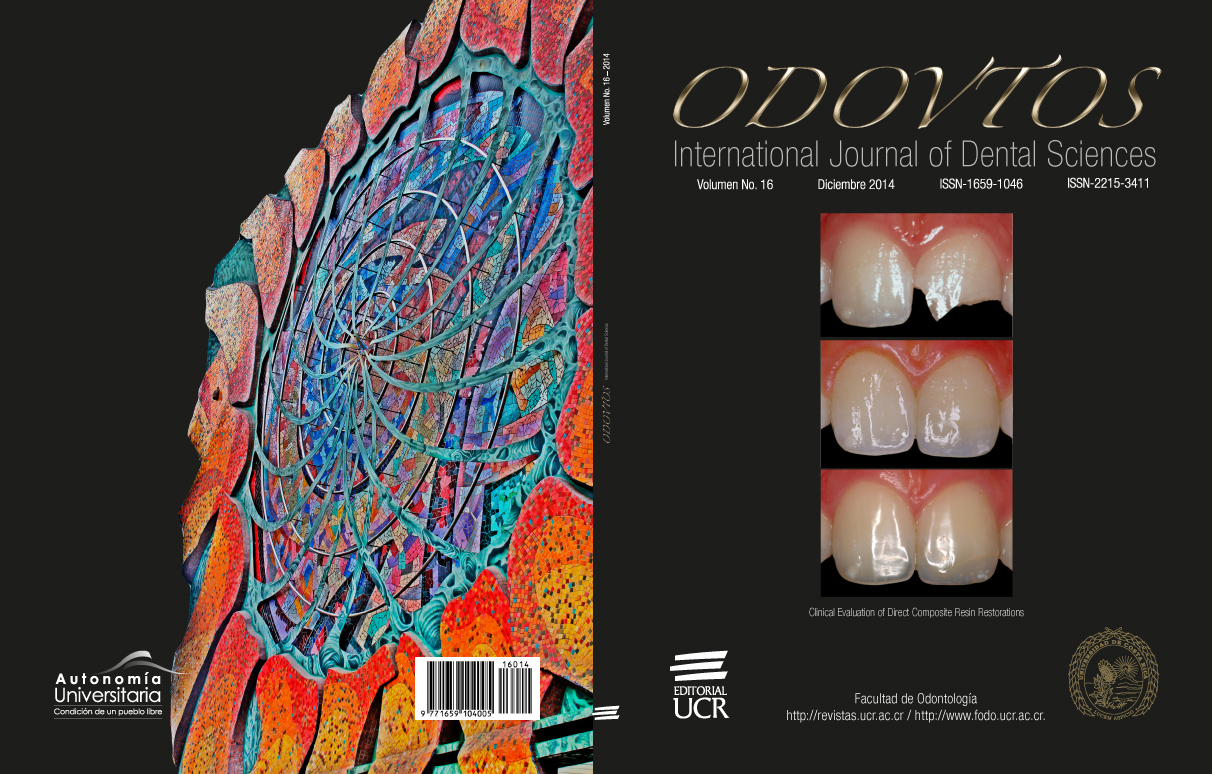Abstract
At the present time, in Costa Rica did not exist a national research on dental trauma, an issue that has become a worldwide public health problem. The aim of this study was to determine the prevalence of traumatic dental injuries of permanent maxillary incisors. Thus, 1 626 Costa Rican school students of 12 years old were evaluated. The national prevalence of children with at least one fracture was 20.17 %, males showed a higher prevalence than women (p < 0.05). Moreover, it was observed that the group of students with more than 6 mm of overjet had a higher prevalence of fractures (p < 0.05).
References
Aldrigui, JM., Jabbar, NS., Bonecker, M., Braga, MM. & Wanderley, MT. (2014). Trends and associated factors in prevalence of dental trauma in Latin America and Caribbean: a systematic review and meta-analysis. Community Dentistry & Oral Epidemiology. 42:30-42.
Andreasen, JO. & Andreasen, FM. (1990). Dental Traumatology: Quo Vadis. Endod Dent Traumatol. 6;78.
Andreasen JO. (1981). Traumatic injuries of the teeth. Copenhagen: Munksgaard. 41-42.
Artun, J., Behbehani, F., Al-Jame, B. & Kerosuo H. (2005). Incisor trauma in an adolescent Arab population. Prevalence, severity and occlusal risk factors. Am J Orthod Dentofacial Orthop. 128; 347–52.
Bhat, M. y Li S-H. (1990). Consumer product- related tooth injuries treated in hospital emergency rooms: United States, 1979-87. Community Dent Oral Epidemiol. 18, 133-8.
Burton, J., Pryke, L., Rob, M. & Lawson, JS. (1985). Traumatized anterior teeth amongst high school students in northern Sydney. Aust Dent J; 30, 346-348.
David, J., Astrom, A. & Wang N.J. (2009). Factors associated with traumatic dental inju- ries among 12-year-old schoolchildren in South India. Dent Traumatology. 5 (25), 500-505. doi: 10.1111/j.1600-9657.2009.00807.x
Dearing, SG. (1984). Overbite, overjet, lip-drape and incisor tooth fracture in children. N Z Dent J. 80, 50-52.
Diaz, JA., Bustos, L., Brandt, AC. & Fernández, BE. (2010). Dental injuries among children and adolescents aged 1-15 years attending to public hospital intemuco, Chile. Dent Traumatol, 26, 254-261.
Bastone, E., Freer, T. & McNamara, J. (2000). Epidemiology of dental trauma: A review of the literature. Australian Dental Journal, 45(1),2- 9. doi:10.1111j.1834-7819,2000.tb00234.x
Fakhruddin, KS., Lawrence, HP., Kenny, DJ. & Locker D. (2008). Etiology and environment of dental injuries in 12- to 14-year-old Ontario schoolchildren. Dent Traumatol, 24, 305-308.
Forsberg, CM. & Tedestam, G. (1990). Traumatic injuries to teeth in Swedish children living in an urban area. Swed Dent J, 14,115-122.
Gabris, K., Tarjan, I. & Rozsa, N. (1996). Dental trauma in children presenting for treatment at the Departament of Dentistry for children and Orthodontics, Budapest, 1985-1999. Dent Traumatol, 12, 60-5.
Galea, H. (1984). An investigation of dental injuries treated in an cute care general hospital. J Am Dent Assoc, 109, 434-8.
Gassner, R., Bosch, R., Tuli, T. & Emshoft, R. (1999). Prevalence of dental trauma in 6000 patiens with facial injuries. Oral Surg Oral Med Pathol Oral Radiol Endod, 87, 27-33.
García, F., Sánchez, R. & Sanchez, J. (1981). Traumatic dental injuries in a sample of Dominican school children. Community Dentistry & Oral Epidemiology, 9, 193-217.
Hamilton, FA., Hill, FJ. & Holloway, PJ. (1997). An investigation of dentoalveolar trauma and its treatment in an adolescent population. Part 1: The prevalence and incidence of injuries and the extent and adequacy of treatment received. Br Dent J, 182,91-95.
Hargreaves, JA., Matejka, JM., Cleateon-Jones, PE., Williams, S. (1995). Anterior tooth trauma in eleven-year-old South African children. J Dent Child, 62, 353-355.
Hinds, K. & Gregory, J. (1995). National diet and nutrition Survey: children aged 1,5 to 4,5 year. Report of dental Survey. London: HMSO.
Kaba, AS. & Marechaux, SC. (1989). A fourteen- year follow-up study of traumatic injuries to the permanent dentition. J Dent Child, 56,417-425.
Kania, MJ., Keeling, SD., McGorray, SP., Wheeler, TT. & King GJK. (1996). Risk factors associated with incisor injury in elementary school children. Angle Orthod, 66,423-432.
Kaste, LM., Gift, HC., Bhat, M. & Swango, PA. (1996). Prevalence of incisor trauma in persons 6-50 years age: United States, 1988-1991. Journal of Dental Research, 75, (Spec. No.), 696-705.
Liew, VP. & Daly, GG. (1986). Anterior dental trauma treated after-hours in Newcastle, Australia. Community Dent Oral Epidemiol, 14, 362-6.
O ́Mullane, D. (1973). Some factors predisposing to injuries of permanent incisors in school children. Br. Dent. J, 134,328-332.
Osuji, OO. (1996). Traumatized primary teeth in Nigerian children attending university hospital: the consequences of delays in seeking treatment. Int Dent J, 46, 165-70.
Sgan-Cohen, HD., Yassin, H. & Livny, A. (2008). Dental trauma among 5th and 6th grade Arab schoolchildren in Eastern Jerusalem. Dent Traumatol, 24,458-461.
Stockwell, AJ. (1988). Incidence of dental trauma in the Western Australian School Dental Service. Community Dent Oral Epidemiol, 16,294-8.
York, A., Hunter, R., Morton, J., Wells, G. & Newton, B. (1978). Dental injuries in 11 to 13 years old children. N. Z. Dent. J.; 74,218-220.
Zaragoza, AA., Catalán, M., Colmena, ML. & Valdemorro, C. (1998). Dental trauma in schoolchildren six to twelve years of age. J Dent Child, 6, 492-4.

